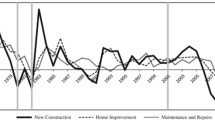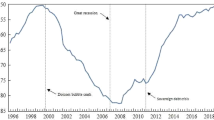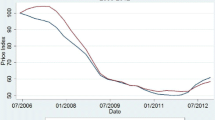Abstract
The model of Hendry (1986) is extended to a vector autoregressive system, in order to examine the sources of fluctuations in housing completions and inventory. The time-series properties of the completion rate are examined as well as those of the accumulated inventory. Shocks to income, interest rates, materials price, and housing price are examined. The completion rate appears to be more or less constant, unaffected by these shocks, so that inventory is evidently the control variable for builders.
Similar content being viewed by others
References
Beaulieu, J., and J. Miron. (1993). ``Seasonal Unit Roots in Aggregate U.S. Data,'' Journal of Econometrics55, 305–328.
Boorah, V. (1979). ``Starts and Completions of Private Dwellings: Four Models of Distributed Lag Behavior,'' Journal of Economic Studies6,204–325.
Campbell, J., and P. Perron. (1991). ``Pitfalls and Opportunities: What Macroeconomists Should Know About Unit Roots.'' In O. Blanchard and S. Fischer, eds., NBER Macroeconomics Annual. Cambridge, MA: MIT Press.
Coulson, E., and C. Richard. (1996). ``The Dynamic Impact of UnseasonableWeather on Construction Activity,'' Real Estate Economics24,179–194.
Engle, R., and C. Granger. (1987). ``Cointegration: Representation, Estimation and Testing,'' Econometrica55, 251–276.
Engle, R., and S. Yoo. (1991). ``Cointegrated Economic Time Series: An Overview with New Results.'' In R. Engle and C. Granger, eds. Long-Run Economic Relationships (pp. 237–266). Oxford: Oxford University Press.
Granger, C., and T. Lee. (1989). ``Multicointegration.'' In Advances in Econometrics. JAI Press. (Vol.8, pp. 71–84).
Granger, C., and N. Swanson. (1997). ``Impulse Response Functions Based on a Causal Approach to Residual Orthogonalization in Vector Autoregressions,'' Journal of the American Statistical Association92,357–367.
Hamilton, J. (1994). Time Series Analysis. Princeton, NJ: Princeton University Press.
Hendry, D. (1986). ``Empirical Modeling in Dynamic Econometrics,'' Applied Mathematics and Computation 20,201–236.
Hylleberg, S. (1986). Seasonality in Regression. New York: Academic Press.
Hylleberg, S., R. Engle, C. Granger, and S. Yoo. (1989). ``Seasonal Integration and Cointegration,'' Journal of Econometrics44,215–238.
Johansen, S. (1988). ``Statistical Analysis of Cointegration Vectors,'' Journal of Economic Dynamics and Control 12,231–238.
Lee, T. (1992). ``Stock-Flow Relationships in U.S. Housing Construction,'' Oxford Bulletin of Economics and Statistics54,419–430.
Maisel, S. (1963). ``ATheory of Fluctuations in Residential Construction Starts,'' American Economic Review53, 359–383.
Mayes, D. (1979). The Property Boom. Robertson.
McGarvey, M., and M. Meador. (1991). ``Mortgage Credit Availability, Housing Starts and the Integration of Mortgage and Capital Markets: New Evidence Using Linear Feedback,'' Journal of the American Real Estate and Urban Economics Association19,25–40.
Pozdema, R. (1988). The Modern Economics of Housing. Quorum Books.
Rosen, K. (1979). Seasonal Cycles in the Housing Market. Cambridge, MA: MIT Press.
Rosen, K. (1984). Affordable Housing. Cambridge, MA: Ballinger Press.
Thom, R. (1985). ``The Relationship Between Housing Starts and Mortgage availablity,'' Review of Economics and Statistics57,693–696.
U.S. Department of Housing and Urban Development. (1995). Current Housing Conditions. Washington, DC: U.S. Government Printing Office.
Author information
Authors and Affiliations
Rights and permissions
About this article
Cite this article
Coulson, N.E. Housing Inventory and Completion. The Journal of Real Estate Finance and Economics 18, 89–105 (1999). https://doi.org/10.1023/A:1007789413307
Issue Date:
DOI: https://doi.org/10.1023/A:1007789413307




